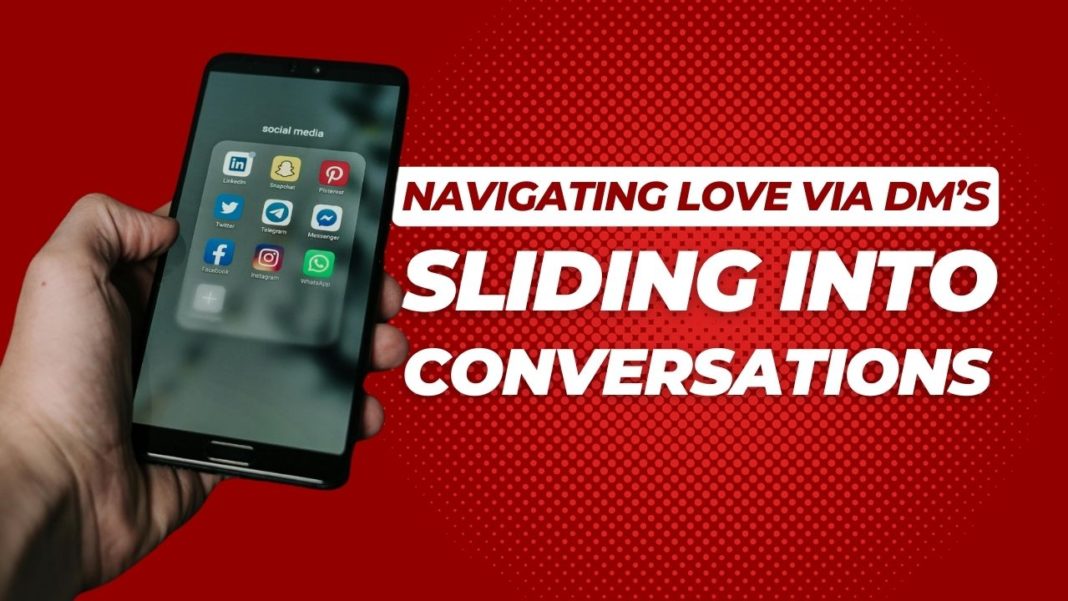In the digital era, the pursuit of love and companionship has transformed dramatically, navigating through an ever-expanding sea of technological advancements. Where once the flutter of a handwritten letter or the nervous anticipation of a telephone call encapsulated romantic communication, today’s connections are often sparked and nurtured through screens. This shift towards digital communication has not only accelerated interactions but also diversified the avenues through which people can connect romantically.
Among these modern methods of forging a connection, the act of ‘sliding into DMs’ (Direct Messages) has emerged as a popular and intriguing phenomenon. Originating from social media platforms, this term describes the initial private message sent to someone with whom one wishes to initiate a conversation, often with romantic intentions. Unlike traditional dating approaches, sliding into DMs allows for immediate and direct contact without the physical or emotional barriers that can inhibit face-to-face interactions.
This direct approach to romantic interest through digital channels opens up a new landscape of possibilities and challenges. It necessitates a unique blend of tact, authenticity, and digital savviness to navigate successfully. In this article, we will explore essential tips for effectively sliding into DMs, ensuring that your digital introduction makes a memorable and positive impression.
The Rise of DMs in Romantic Communication
The pathway to romance has historically been paved with a myriad of communication methods, each reflective of its era’s technological capabilities and cultural norms. In centuries past, love letters exchanged over months set the stage for romantic courtships, offering glimpses into the hearts of lovers separated by distance. As technology evolved, so did the modes of communication. The advent of the telephone brought instant voice connections, shrinking the emotional distance between individuals. By the late 20th century, emails introduced a new immediacy to digital love letters, combining the speed of the telephone with the thoughtful prose of letters.
With the turn of the millennium, instant messaging took precedence, allowing real-time text-based conversations to unfold seamlessly. Each of these shifts reflected broader societal changes, from the speed of communication to the privacy with which individuals could express their romantic feelings.
However, the real transformation came with the rise of social media platforms. Platforms like Facebook, Instagram, and Twitter, along with dating apps such as Tinder and Bumble, have redefined the landscape of romantic interactions. These platforms provide not just a space for public socialisation but also private corners where individuals can initiate personal conversations through direct messages (DMs).
Social media has effectively democratised access to potential partners. Unlike traditional dating scenarios constrained by physical or social boundaries, DMs allow anyone to reach out to virtually anyone else, provided they have a digital presence. This level of accessibility has made DMs a crucial tool in the modern dating toolkit.
Recent statistics underscore the significant role of DMs in modern relationships. According to a survey by Pew Research Center, nearly 30% of teenagers report having used social media to express romantic interest in someone by commenting, DMing, or otherwise making a connection. Furthermore, data from dating sites reveal that a substantial number of relationships now start from a simple DM—marking a shift from the profile and message-based interactions traditionally favoured on dating platforms.
This trend highlights not only the evolving mechanisms of romantic pursuit but also the changing norms around privacy, immediacy, and accessibility in romantic communication. The ease with which one can slide into someone’s DMs has transformed many aspects of dating, introducing both opportunities and challenges that were previously non-existent in the analogue world of romance.
Understanding the Do’s and Don’ts
First impressions are crucial, and in the realm of digital communication, they can be even more pivotal. The initial message in a direct message (DM) exchange acts much like a digital handshake—too weak, and you fail to leave an impression; too strong, and you may come off as overbearing. The challenge is magnified by the absence of non-verbal cues, making the content of your first message instrumental in setting the tone for potential future interactions.
Tips for Crafting an Engaging Opener
Personalisation: Begin by showing that you have taken an interest in the person beyond just their profile photo. Reference specifics from their profile or shared interests. This not only shows effort but also establishes a foundation for a conversation that extends beyond superficialities.
Humour: A well-placed joke or witty remark can break the ice and reduce the inherent tension of reaching out to a stranger. However, it’s crucial that the humour is appropriate and considerate, avoiding anything that could be misinterpreted or offensive.
Relevance: Tie your opener to something timely or topical. If their profile or recent posts suggest they enjoy certain activities, a comment or question related to these topics can spark a lively conversation. For example, asking for a book recommendation if they’ve posted about reading or querying about a recent travel destination they’ve shared.
Common Pitfalls to Avoid
Being Too Forward: While it’s important to be clear about your intentions, overly aggressive or romantic overtures can be off-putting. It’s better to ease into these topics as you gauge the other person’s interest and comfort level.
Clichés: Starting with “Hey, beautiful” or “What’s up?” can be too generic and imply a lack of effort. These overused openers often signal a lack of creativity and do not encourage a meaningful response.
Spammy Messages: Copy-and-pasted messages are easy to spot and often suggest that you are casting a wide net rather than genuinely interested in the individual. Personalised messages are far more effective in demonstrating genuine interest.
The Art of Conversation in DMs
Mastering the art of conversation through direct messages (DMs) is essential for developing and maintaining romantic interest in the digital age. Effective DM communication requires not just sparking interest but also sustaining it over time, creating a connection that feels both engaging and respectful.
Maintaining Interest and Building Rapport
Consistency in Communication: Regular, but not overwhelming, messages help keep the connection alive and show sustained interest. It’s important to find a rhythm that works for both parties, acknowledging that everyone has different expectations and time constraints.
Deepening Conversations: Progressing beyond superficial topics can foster a deeper connection. Sharing personal anecdotes, insights, and emotions can enhance intimacy, making the exchanges more meaningful and memorable.
Active Listening: Show that you are paying attention to the details. Refer back to things they’ve said in past conversations. This not only validates the person’s feelings and experiences but also reinforces their importance in the ongoing dialogue.
Balancing Engagement and Respecting Boundaries
Reading the Room: Pay attention to cues that might indicate their comfort levels. If responses become shorter or less frequent, it might be a sign to slow down or switch topics.
Privacy Respect: Avoid prying into overly personal areas unless they open those doors. Respecting privacy in DMs is crucial, as it fosters trust and demonstrates that you value their boundaries.
Consent in Conversation: Ensure that both parties are comfortable with the topics being discussed. If venturing into sensitive territories, it’s polite to ask if they’re open to discussing those issues.
Techniques for Keeping the Conversation Flowing
Open-Ended Questions: Encourage dialogue by asking questions that require more than a yes or no answer. For instance, instead of asking, “Did you have a good day?” you might ask, “What was the best part of your day?”
Sharing Interests: Find common ground or introduce each other to new topics, hobbies, or experiences. Sharing links to articles, videos, or music can not only spice up the chat but also provide more avenues for discussion.
Using Multimedia: Utilising the full range of communication tools available on most social media platforms can enhance the conversation. Sending photos, videos, or voice notes can make the interaction feel more personal and lively. For example, sharing a quick video of a place you visited or a photo of something interesting you saw can add a visual element to the conversation, making it more engaging.
Transitioning Beyond DMs
As digital interactions blossom into genuine connections, there comes a point when the conversation may naturally progress beyond the confines of DMs. Recognizing the right moment and manner to transition can enhance the potential for a more substantial relationship.
Signs That a Conversation is Ready to Move Off Social Media
Consistent Engagement: Both parties are actively participating in the conversation, showing enthusiasm through frequent and thoughtful replies.
Personal Disclosure: You’ve both shared personal stories or feelings, which indicates a level of trust and comfort.
Mutual Interest: There are clear indications of mutual curiosity and interest in exploring the relationship further, perhaps through mentions of meeting up or talking on the phone.
Appropriate Ways to Suggest Voice Calls, Video Chats, or In-Person Meetings
Natural Progression: Introduce the idea as a natural extension of what you are already discussing. For example, if you’ve been discussing a film, you might suggest watching it together online or in person.
Casual Suggestion: Frame your suggestion casually and give the other person a chance to opt-in comfortably. Phrases like, “Would you be up for a video chat sometime? I’d love to continue this conversation face-to-face!” can be effective.
Open-Ended Invitation: Allow them to have a say in the planning. This could involve asking about their schedule or preferences, which shows respect for their time and comfort.
Safety Tips for Transitioning from Online to Offline Interactions
Public Meeting Place: For the first meeting, choose a public and familiar place. This provides a safe environment for both parties.
Inform Someone: Let a friend or family member know about your plans, including when and where you’ll be meeting.
Keep Personal Information Private: Continue to protect your privacy by not sharing your home address, financial information, or other sensitive details until a deeper, mutual trust is established.
Set Clear Expectations: Discuss expectations openly before meeting. If it’s just a casual meet-up, make that clear to avoid any misunderstandings.
Trust Your Instincts: Pay attention to any feelings of discomfort or red flags, whether before or during the meetup. If something doesn’t feel right, it’s okay to reschedule or cancel.
Transitioning from DMs to more personal forms of communication is a significant step in any evolving relationship. By ensuring the transition is smooth, consensual, and safe, individuals can foster a more meaningful connection that respects the boundaries and comfort of both parties.
The Role of Etiquette and Consent
In the age of digital communication, understanding and adhering to principles of etiquette and consent is not just courteous—it’s crucial. These principles ensure that interactions remain respectful and considerate, setting a foundation for healthy and mutually satisfying relationships.
Understanding and Respecting Digital Boundaries
Ask Before Sharing: Always ask for permission before sharing personal content such as photos or sensitive information. This respects the other person’s privacy and comfort levels.
Mind the Timing: Being mindful of when you send messages can show respect for the other person’s time. Avoid sending messages at odd hours unless you know the person well enough to understand their schedule.
Respect for Digital Space: Recognise that each individual has a different level of comfort with digital communication. Some may prefer lengthy conversations, while others might favor brief exchanges. Attune to these preferences and adjust your communication style accordingly.
The Importance of Consent in Digital Communication and Progressing Relationships
Explicit Consent: Always ensure that the other person is comfortable with the direction and depth of the conversation. This includes escalating the relationship to more personal levels or shifting to different communication platforms.
Continuous Consent: Consent is an ongoing process. Regular check-ins about the other person’s feelings can help maintain a comfortable pace and ensure that both parties are still on the same page.
Acknowledging Autonomy: Recognise that consent can be withdrawn at any time, and this decision should be respected without question. Continuing a respectful dialogue after consent has changed can help maintain trust and openness in the interaction.
How to Handle Rejection or Disinterest Gracefully
Acceptance: If someone expresses disinterest, acknowledge their feelings respectfully. A simple response like, “Thank you for letting me know. I appreciate your honesty,” can maintain dignity for both parties.
No Persistence: Avoid the temptation to persuade or question their decision. Respecting their choice helps preserve your self-respect and their comfort.
Positive Closure: Leave the conversation on a positive note if possible. Expressing goodwill, such as “I’ve enjoyed our chat, and I wish you all the best!” can help end the interaction smoothly.
Reflect and Learn: Use the experience as an opportunity to reflect on what might be learned from the interaction. Understanding any missteps or miscommunications can improve future interactions.
The principles of etiquette and consent are integral to navigating the complexities of digital communication, especially in romantic contexts. By embracing these values, individuals can foster safer, more respectful, and ultimately more fulfilling connections in the digital realm.
Conclusion
In this exploration of love and communication in the digital age, we have navigated through the nuances of initiating and maintaining digital dialogues, from crafting the perfect opener in DMs to gracefully transitioning conversations beyond the confines of social media. At every step, the importance of personalisation, respect for privacy, and adherence to digital etiquette has been emphasized.
Personalisation and Engagement: Crafting engaging and thoughtful openers and sustaining interest with deep, meaningful conversations are crucial. This personal touch not only captivates interest but also builds a foundation for genuine connection.
Respecting Boundaries and Consent: The role of etiquette and the continuous pursuit of consent underline all interactions. Respecting digital boundaries and ensuring comfort are paramount in fostering trust and respect in any budding relationship.
Handling Transitions and Rejections: Knowing when and how to transition conversations off digital platforms into more personal interactions, and handling any potential rejections with grace and dignity, are both critical skills in the digital dating realm.
As we continue to navigate these digital pathways, the imperative for positive and respectful communication remains constant. The landscape of love may continue to evolve with each technological advancement, but the core principles of mutual respect, understanding, and kindness remain timeless.
In this digital era, as we slide DMs and forge new connections, let us remember that behind every screen is a human heart. In our quest for love and companionship, let us use the tools of technology to enhance, not overshadow, the profound human connections that sustain us.






